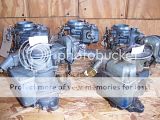To start with, holy SMOKES the upgrade has been better than I had hoped! For those that haven't been following, I updated a stock setup with a new top end and cam. I have a C9 head that was modified for a 2 bbl conversion, 1.75/1.5 valves, 264/274 110* Clay Smith cam, 1.65 RAU rockers, and a slew of other small changes. It's night and day different.
My problem is the amount of carbon I'm blowing out the tailpipe. I'm using a 1.14 venturi Autolite 2100. I plan on attempting to address this over the winter. My problem is that I know Jack and sh!+ about tuning carbs, and Jack just left town.
The last time I measured manifold vacuum, I got something like 14". I don't know if this is good/bad with this cam. I had to do some "backwoods engineering" (ok....I'm a redneck and find oddball solutions....) to get my carb setup to work. Is this in the ballpark of expected or do I have a vac leak?
If this is normal, do I need a 7.0 power valve?
How should I be jetted? Is there a scientific method of determining jet size? Or am I stuck with trial and error?
Any other Autolite 2100 recommended mods?
On another note, a co-worker has a lift. Will try to get on there this spring to get the header and Arvinode exhaust installed.
My problem is the amount of carbon I'm blowing out the tailpipe. I'm using a 1.14 venturi Autolite 2100. I plan on attempting to address this over the winter. My problem is that I know Jack and sh!+ about tuning carbs, and Jack just left town.
The last time I measured manifold vacuum, I got something like 14". I don't know if this is good/bad with this cam. I had to do some "backwoods engineering" (ok....I'm a redneck and find oddball solutions....) to get my carb setup to work. Is this in the ballpark of expected or do I have a vac leak?
If this is normal, do I need a 7.0 power valve?
How should I be jetted? Is there a scientific method of determining jet size? Or am I stuck with trial and error?
Any other Autolite 2100 recommended mods?
On another note, a co-worker has a lift. Will try to get on there this spring to get the header and Arvinode exhaust installed.





